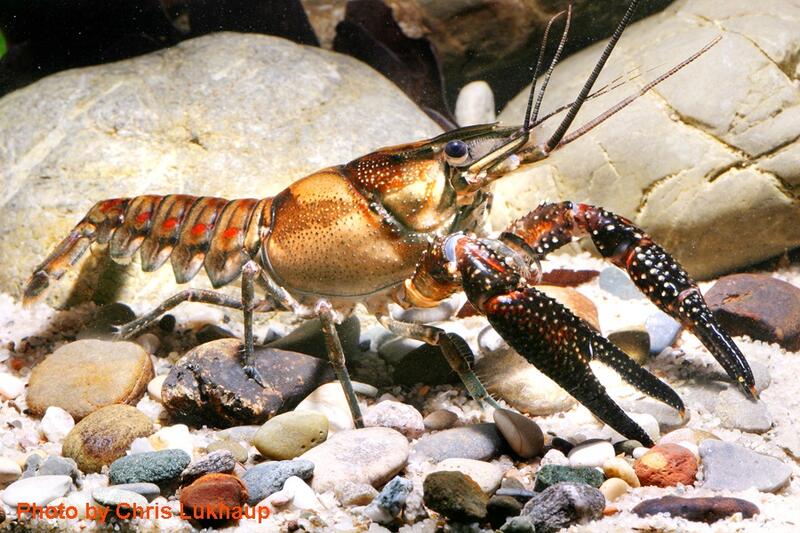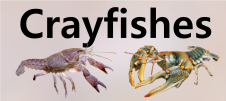







Loading profile. Please wait . . .
Procambarus spiculifer (LeConte, 1856)
White Tubercled Crayfish




Federal Protection: No US federal protection
State Protection: No Georgia state protection
Global Rank: G5
State Rank: S5
Element Locations Tracked in Biotics: No
SWAP 2015 Species of Greatest Conservation Need (SGCN): No
SWAP 2025 Species of Greatest Conservation Need (SGCN): No
2025 SGCN Priority Tier: None
Element Occurrences (EOs) in Georgia: 0
Habitat Summary for element in Georgia: Georgia habitat information not available
The overall appearance of the White Tubercled Crayfish is brownish to bluish with dark markings. As the name implies, the claws are dark with whitish tubercles; the claws can be quite large on males in reproductive condition. The carapace typically has a dark saddle near its rear edge that extends forward on either side of the carapace as two “horns." The most obvious pigmentation characteristics are the discrete reddish or purplish spots along the margins of the abdomen. The rostrum is long and sharply pointed and there are two distinctive cervical spines on either side of the carapace. Adult White Tubercled Crayfish may reach a maximum total body length of over 100 mm (>4 in).
The presence of two cervical spines separates the White Tubercled Crayfish from all Georgia species except other species formerly placed in the subgenus Pennides (total of 5 species). One of these species, the Disjunct Crayfish, (Procambarus raneyi), is very similar and may occur with the White Tubercled Crayfish in the Broad and Ocmulgee river systems. However, the palms of the Disjunct Crayfish are light with dark tubercles rather than dark with light tubercles. There are also differences in the male reproductive structure which must be examined using magnification. The White Tubercled Crayfish could also occur (however unlikely) with the very similar Muckalee Crayfish (P. gibbus) in the mainstem Flint River. Details of the first pleopods of first form males are required to separate these two species.
The White Tubercled Crayfish is found in a wide array of flowing water habitats across its range. Depending on the substrates available it can be found hiding beneath rocks, within woody debris or leaf litter, and beneath undercut banks.
No studies of the White Tubercled Crayfish diet are known. Crayfishes are considered opportunistic omnivores and likely feed on live and decaying vegetation, aquatic insect larvae, small fishes, and dead animal matter.
Stream dwelling crayfishes typically hide during the day and come out at night to feed. Reproduction usually occurs during the spring and fall, but males in reproductive condition may be found at any time during the year. When female crayfish are ready to lay eggs, they usually find a secure hiding place and hence are rarely encountered. When the eggs are released, the female attaches them to her swimmerets and is said to be “in berry.” Upon hatching, the juvenile crayfish are attached to the mother by a thread. After the juveniles molt for the second time, they are free of the mother, but stay close and will hold on to her for some time. Eventually they move off on their own. Crayfishes molt 6 or 7 times during their first year of life and most are probably able to reproduce by the end of that year. Males in reproductive condition have been collected in all months except January. Hobbs (1981) listed numbers of eggs for seven ovigerous females between 22 and 363. He suggested that eggs had been lost from the female with the lower number. These females were collected in April, May, and August. White Tubercled Crayfish are probably mature after their first year of life and live a maximum of about three years (Hobbs 1981).
In rocky streams most easily collected by holding a net perpendicular to the current downstream of a large rock, then lifting the rock and disturbing the substrate beneath it. If a crayfish is hiding underneath the rock, it will likely move into the net. Use the same technique in streams with woody debris or aquatic plants. Shocking downstream into a seine net with a backpack electroshocker is also effective. Setting baited minnow traps overnight will likely yield specimens as well. Collections in spring or fall are more likely to produce males in reproductive condition which can be helpful with identifications.
The White Tubercled Crayfish is found from the upper Savannah River system in South Carolina, south and west to the Mobile Basin in Alabama (Hobbs 1989). It is the most widespread and arguably the most common crayfish in Georgia and is known from all major river systems in the state except the Chattooga (Coosa), the Ogeechee, and the lower Savannah (Hobbs 1981). It has apparently been introduced into the Nottely River system (Tennessee River drainage) in northern Georgia.
This species is threatened in Georgia by land uses within its range that could alter hydrology and water quality. Introduction of non-native species is a threat to all native crayfishes.
This species is common and widespread in Georgia and is thus considered secure. However, it is apparently being replaced in the lower Flint River system by the Gray-speckled Crayfish, Orconectes palmeri (Sargent et al. 2011).
General watershed level protection measures will help secure the continued existence of the White Tubercled Crayfish in Georgia. These include the protection of riparian zones, control of sediment and nutrient runoff from farms and construction sites, and limiting the amount of impervious cover (e.g., pavement) within occupied watersheds. Non-native crayfishes should never be used for bait. Instead, anglers should use crayfishes collected from the river system they will be fishing in and should never release unused bait crayfish back into Georgia waters.
Hobbs, H.H., Jr. 1981. The crayfishes of Georgia. Smithsonian Contributions to Zoology 318:1–549.
Hobbs, H.H., Jr. 1989. An Illustrated checklist of the American crayfishes (Decapoda: Astacidae, Cambaridae, and Parastacidae). Smithsonian Contributions to Zoology 480:1–236.
Sargent, L.W., S.W. Golladay, A.P. Covich, and S.P. Opsahl. 2011. Physicochemical habitat association of a native and a non-native crayfish in the lower Flint River, Georgia: implications for invasion success. Biological Invasions 13:499–511.
Taylor, C. A., G. A. Schuster, J. E. Cooper, R. J. DiStefano, A. G. Eversole, P. Hamr, H. H. Hobbs III, H. W. Robison, C. E. Skelton, and R. F. Thoma. 2007. A reassessment of the conservation status of crayfishes of the United States and Canada after 10+ years of increased awareness. Fisheries 32:372–389.
Christopher E. Skelton
C. Skelton, September 2012: original account
C. Skelton, March 2019: general update of account.
D.Weiler, September 2019: photo added